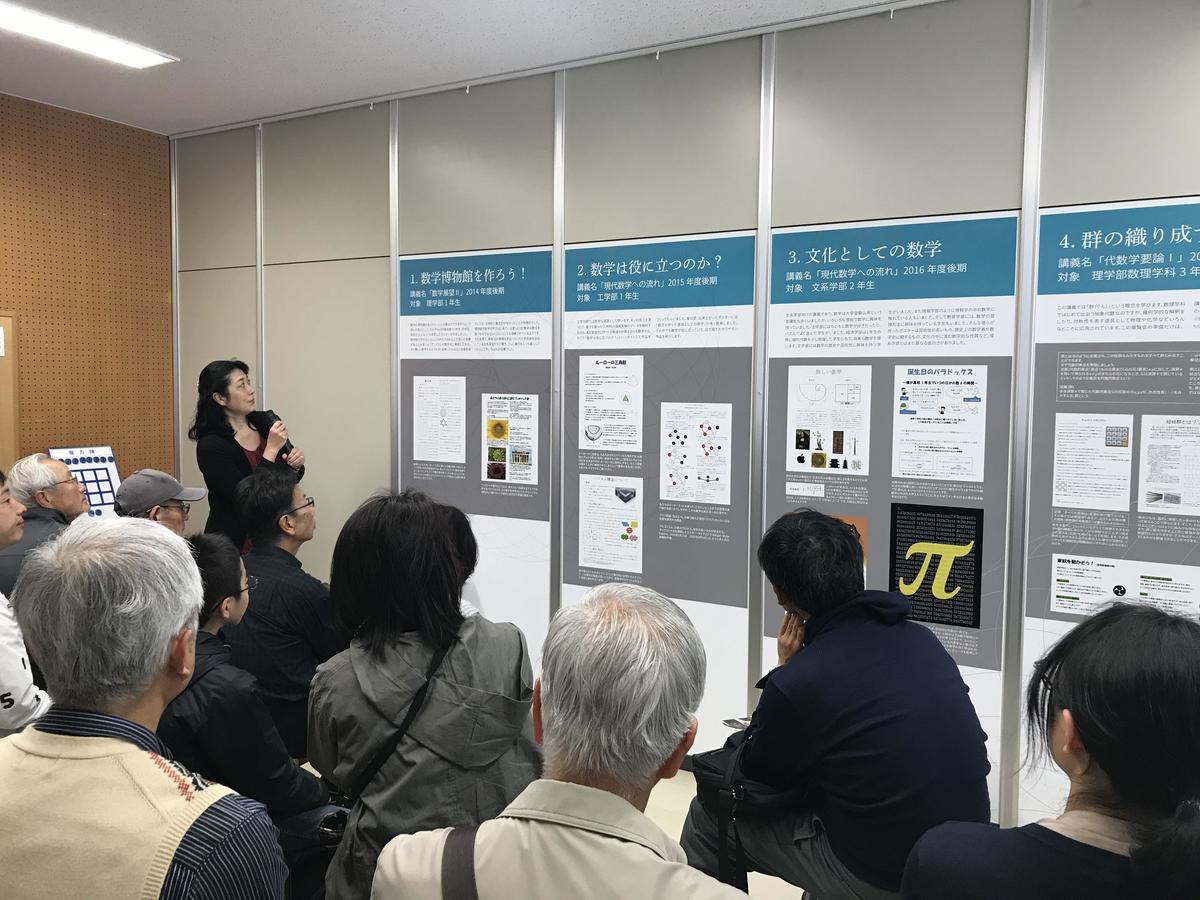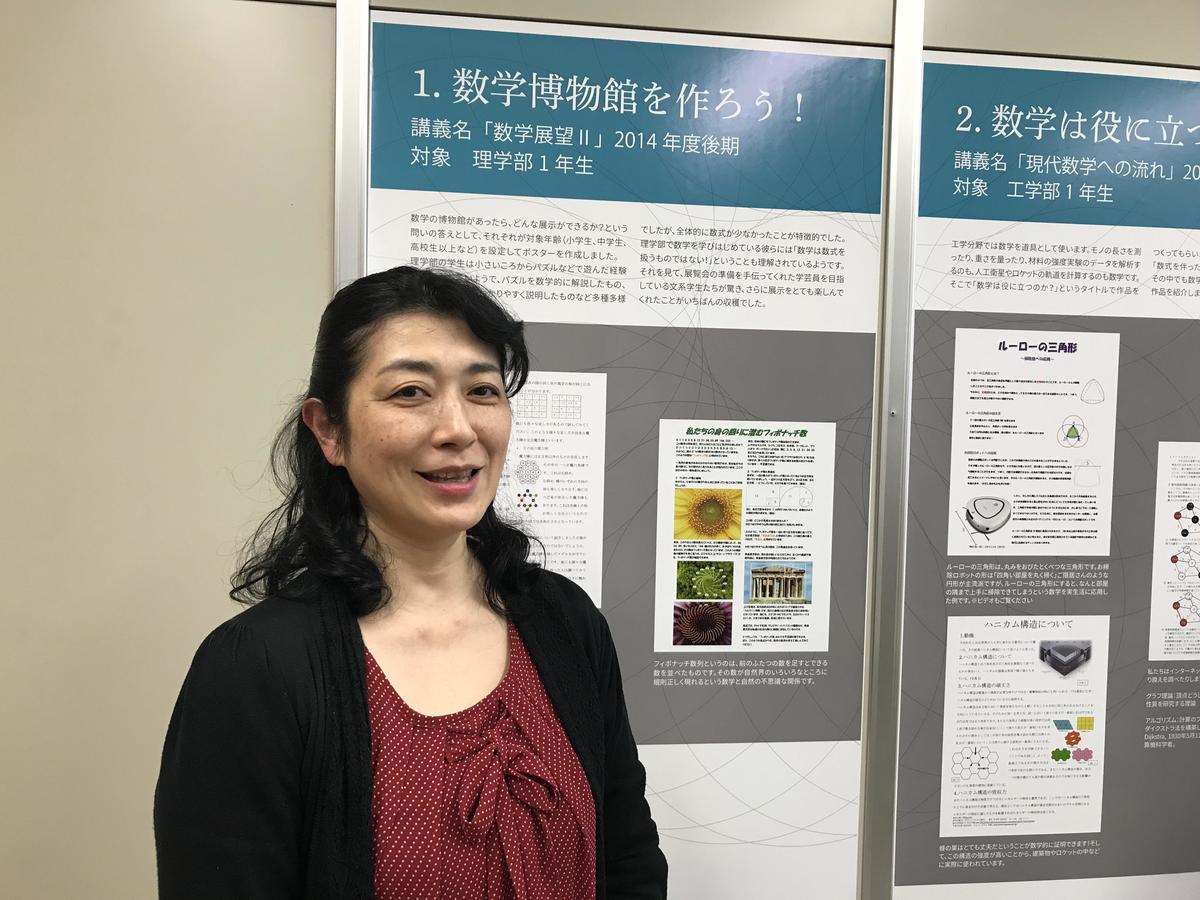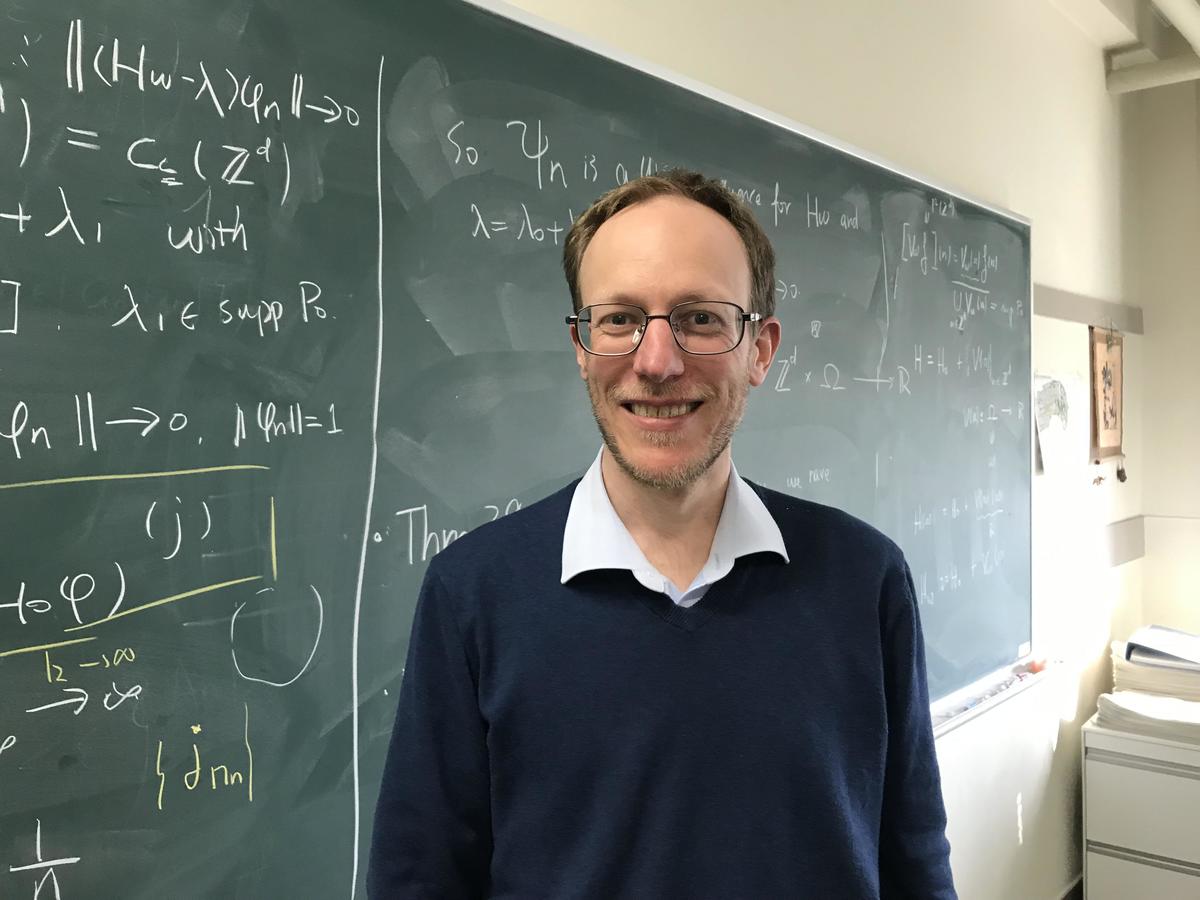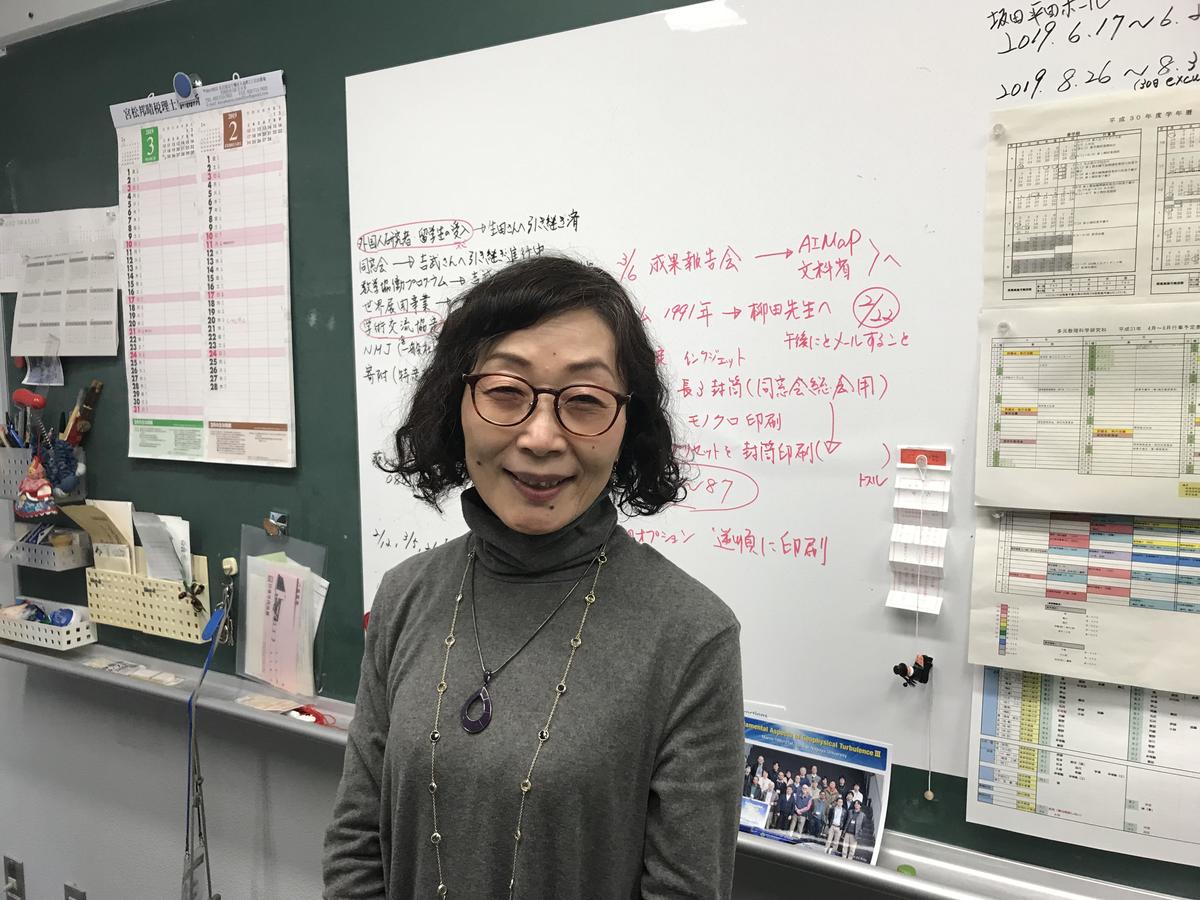April 18, 2019
Mathematics and People around It
It goes without saying that research and education at universities would not be possible without the support of many people working in different roles. Some of these activities are common across all disciplines, while others are unique to a specific field. This spring, I visited a number of people working in mathematics who have reached a milestone in their career. People often feel that mathematics is unapproachable to the layman, but my interviews have revealed the various faces of mathematics.
First up is Yukari Ito, formerly Associate Professor at the Nagoya University Graduate School of Mathematics, who was the leading figure in the university's project to create a museum of mathematics. I say "was" because she has just left Meidai this April to focus on her role as a professor at the Kavli Institute for the Physics and Mathematics of the Universe at the University of Tokyo Institute for Advanced Studies. In 2014, she started asking students taking her lectures what they imagined a math museum would house. A spot exhibition at the Nagoya University Museum titled "Beautiful Mathematics", which ended in mid-April, was the culmination of this project and showed works produced by her students. Her gallery talk, which was held at the exhibition venue at the end of March, brought mathematics close to our daily life and ended with the audience asking questions after questions.
 A large audience eagerly listened to Ito’s gallery talk
A large audience eagerly listened to Ito’s gallery talk
We are familiar with the concept of science museums, but a museum of mathematics? Ito explains that they already exist in other countries, and that science museums often include math-themed displays. Their aim is to make mathematical theories and problems accessible and enjoyable to all, using a variety of exhibits such as geometric models and calculation tools. She had visited many museums with her elementary-school child, and was struck by the near absence of math-related exhibition at Japanese museums, which led to her decision that, if there wasn't any yet, she was going to create one.
Students have produced a wide range of works in their effort to demonstrate how math is in everyday life and fascinating. Take, for example, the Fibonacci numbers: a sequence of numbers starting 0, 1, 1, 2, 3, 5, 8, 13, 21, 34 and so on, where each number is the sum of the previous two. The nature is full of these numbers manifesting themselves in many different ways, such as the number of petals on many flowers and the number of spirals on sunflower seed heads. You can lay square tiles whose side lengths are Fibonacci numbers to make what is known as the golden rectangle. The ratio of its side lengths, 1:1.618 (roughly 5:8), is the golden ratio, which is well known as the standard of beauty in the western civilization; the Parthenon temple and the Venus de Milo sculpture as just two of the many examples where the golden ratio is used. It's intriguing and fascinating to learn that the ratio is also used in modern applications such as TV and computer screens and business cards.
Another student looked at a different ratio, 1:1+√2 (roughly 5:12), known as the silver ratio, which produces a rectangle slightly dumpier than the golden rectangle. The silver ratio can be seen in the five-story pagoda of Horyuji, Hishikawa Moronobu's "Beauty looking back" and even in the body shape of Japanese popular cartoon character Doraemon. It's popularity in Japanese art and architecture has given rise to another name, yamato-hi or the Japanese ratio, which is also used in the standard dimensions of A and B paper sheet sizes and of tatami mats.
A robot vacuum cleaner in the shape of a Reuleaux triangle - an equilateral triangle with curved edges - cleans corners of rooms better than circular one. The honeycomb structure is found in structural parts of buildings and rockets as its strength is mathematically proven. Google's search engine uses linear algebra sequences. These examples show that mathematics helps us in many aspects of our everyday life.
 Yukari Ito, now Professor at the University of Tokyo, is actively involved in many areas beside research; her book Kenkyu surutte omoshiroi!: kagakusha ni natta 11-nin no monogatari (Research is fun!: the story of eleven who became scientists, Iwanami Jun
Yukari Ito, now Professor at the University of Tokyo, is actively involved in many areas beside research; her book Kenkyu surutte omoshiroi!: kagakusha ni natta 11-nin no monogatari (Research is fun!: the story of eleven who became scientists, Iwanami Jun
It's interesting to note how students from different departments approached their brief to create math displays differently. Ito points out that freshmen from the School of Science tended not to use mathematical formulae in the works, with some opting for hand-drawn posters, whereas the output from the School of Engineering used many formulae and were neatly produced using computers. Perhaps science students, who are constantly told how complicated formulae look, decided to avoid using them? Engineering students, on the other hand, seem to see mathematics as a useful tool and have no hesitation in using formulae. Ito was surprised by the clear difference in the attitude of science and engineering students to math even at the start of their study.
Many of the sophomores from humanities and social sciences courses, on the other hand, had not used mathematics at all since the university entrance exams; there were some exceptions, though, such as a law student who had always liked math and economics students who are used to using math as part of their study. It was humanities students who picked up on the cultural difference between the east and the west through the comparison of the golden and silver ratios. Other contributions included an artwork featuring the decimal digits of Pi and a display on the history of mathematics. "Their works were interesting in ways that were quite different from STEM students' output," says Ito.
Third-year students from the Department of Mathematics in the School of Science opted for a more specialist piece explaining the abstract concept of a group, which they had just learned, through visual expressions. Variations in repetitive geometric patterns used in textiles and paper designs seem endless, but, when one focuses on elements such as parallel shifts, rotations and mirror images, there are apparently only 17 groups in total. These are called the wallpaper groups, and the display explains these groups using traditional Japanese patterns such as asanoha (hemp leaf) and shippo tsunagi (linked seven treasures) as examples. The concept of a group also relates to symmetry, a familiar concept in the fields of physics and chemistry. The display gives us a glimpse of the world of mathematics that connects familiar design patterns to cutting-edge science, even though the theory itself is beyond our understanding.
These varied outputs show that math can mean many things to many people, with different ways of appreciating it. This, I guess, must mean that there are many different ways to approach and teach mathematics. As part of the three Rs of reading, writing, and arithmetic, mathematics is one of the essential life skills. And in today's IT society, which is founded on mathematics, having some knowledge of math - whether at a basic level or in depth - is hugely important to everyone. The mathematics museum initiative, with the aim of making math accessible to as many people as possible, has never been more relevant. The students who told Ito that they had fun producing exhibits for the museum as part of their course must have gained a lot from their own perspective, whether they were from STEM or humanities and social science departments. Ito's specialism is singularity, and her research at the University of Tokyo spans mathematics and physics. I hope that her legacy at Meidai and the spirit that captivated students from across many different fields will live on.
 Designated Professor Serge Richard
Designated Professor Serge Richard
"There's something like a mathematics museum at the University of Lyon, where I used to work," says Designated Professor Serge Richard, who gives special lectures on mathematics in the G30 (Global 30) international program, where courses are taught in English. This March, he was given the Excellent Teacher Award in the Institute of Liberal Arts and Sciences for his role in attracting Japanese students to English-taught lectures and bringing Japanese and overseas students together to achieve outstanding results.
Richard, a Swiss national, studied at universities across Europe. While he was a visiting scholar at Tsukuba University, he had a chance to visit Nagoya University and had a good impression of its environment. He responded to Meidai's recruitment call for G30 faculty and joined in 2013 from his post at the University of Lyon. The education system varies from country to country, and the difference can impact students' attainment levels beyond their abilities, so he was attracted by the prospect of teaching a diverse mix of students who came from different countries and helping them to fulfill their potential. Now that he is putting this very idea into practice, he says he finds the job highly rewarding.
The special mathematics lectures were Richard's own initiative, which he started on a voluntary basis in 2017. Mathematics lectures on the G30 program taught by Richard and other G30 faculty members are at the freshman and sophomore levels, but no English-taught upper-level classes are offered by the undergraduate school. He responded to students' call for lectures at this level by providing a weekly lecture in an evening slot from 6:30pm to 8pm. News of this exciting new program spread to Japanese students, who also decided to join in. They were amazed to see how G30 students listened intently without even taking notes and bombarded the teacher with questions, and many found this environment stimulating. In order to help the Japanese students who lacked confidence in their English ability, Richard created peer-to-peer study sessions where G30 students and Japanese student got together and students taught each other. Recognizing the achievement of Richard's lectures, the university made them an official part of the curriculum open to all students in 2018. Feedback from some of the Japanese students who took part in the lectures notes how their attitude to learning was transformed by their contact with G30 students.
With a broadened outlook and newfound confidence, some of these Japanese students are now studying abroad and making presentations at overseas conferences. To showcase their achievements, Richard has created a video titled Deep Impact 2018, in which Japanese students who studied on the G30 program talk about their experience, and posted it on the university website. One of the students featured is Naohiro Tsuzu, who was a third-year student in the Department of Mathematics at the time. "He was only able to speak a few words when he started," says Richard, "but managed to make a one-hour speech in English in front of experts after a year and half." A secret of this remarkably rapid progress may lie in Richard's teaching method; he asks students to read aloud mathematical formulae as they write them on the blackboard. "Students already have a solid knowledge of grammar. By hearing their own spoken English, they gradually get used to speaking English." Perhaps this method works well because of the nature of mathematics, but this shows that there are plenty of tricks that can be used to help Japanese students gain confidence in their English ability.
Another student, Takashi Furuya, who was a first-year doctoral student at the Graduate School of Mathematics at the time, explains on the video that G30 helped him overcome his apprehension about speaking English - so much so that he was going to study in Germany from the following month. "I feel so proud to see my students grow," says Richard.
To build on these achievements, a new project to provide more support for Japanese students, including English-medium supplementary sessions, was launched in the last autumn semester to encourage wider participation in the G30 program. Providing a place where more Japanese students have an opportunity to study and learn with overseas students was the original objective of the G30 program and, slowly but surely, it is happening.
Professor Emeritus Yoichi Oda, who is in charge of the G30 program, is full of praise of Richard's achievements: "He is one of the people leading our drive to internationalize Meidai's education."
Richard confesses that, when he started teaching Japanese students, he was astonished to find that most of them did not have their passports. His experience in Europe had made him assume that any university students would have travelled abroad at some point in their life. G30 must have played a catalytic role in getting these students to look outward.
Another stalwart of mathematics at Meidai is Kazuko Kozaki, who started working in the mathematics department half a century ago, long before campus internationalization became a topic of conversation here. Unlike other disciplines in the School of Science such as physics and chemistry, where research is centered around laboratory experiments, mathematics does not have a team structure in which postgraduate and undergraduate students provide research support. Mathematics is very much an individual pursuit, where each researcher carries out their own research alone. This means that administrative staff play an important - even an essential - role in providing support to make research possible at all.
"It was the presence of secretaries and librarians who supported mathematicians as they conducted their research that made Japan's mathematics world class," insists Professor Emeritus Yukihiko Namikawa, a mathematician who previously served as the Dean of the Graduate School of Mathematics. This is also true in the mathematics departments at the University of Tokyo and Kyoto University, and Kozaki is recognized as one of the stalwarts supporting Japanese mathematics.
One example of her roles has been an editor of the Nagoya Mathematical Journal, an internationally respected academic publication founded in 1950. The journal publishes peer-reviewed papers, some of which are submitted from abroad. Although it is now published by the Cambridge University Press and Meidai is no longer involved in the administrative aspects of publication, Kozaki had played a central role in the editorial process, from corresponding with authors and reviewers to proofreading.
Her job ranges far and wide; whether it's organizing international research events, inviting overseas academics or signing academic exchange agreements, it's Kozaki who does the administrative work. In other words, the department would not function without her.
Whenever there's a problem, researchers rush to Kozaki's office, which some call the nurse's room. "I actually had someone come here for a sticking plaster," laughs Kozaki.
Originally from Fukui Prefecture, Kozaki graduated from high school in 1969 and took a civil servant exam in Nagoya as it was close to Iwakura City in Aichi Prefecture, where some of her relatives lived. She received numerous interview invitations, one of which was from Meidai. At the interview, she said that she wanted to be close to the frontline of actions, and that she hated math. She was hired and placed in the administrative office of the Department of Mathematics in the School of Science. Some time later she learned why: they had thought that someone who hated math would be respectful of mathematics experts.
When she started the job in 1970, she wondered if she might end up leaving after 2-3 years, but looking back, Kozaki says: "The job was interesting because I was tasked to do so many different things. Half a century just flew past." Recognizing the importance of the role played by administrative staff, the mathematics department has been keen to help their development. This meant that she was given opportunities to take part in training programs outside Meidai as well as abroad, for which she is grateful.
She has spent her entire career in the same workplace, and it was her own choice not to move to a different department. When she reached the official retirement age of 65 in an assistant position, she was placed in the secretarial office on a part-time basis. This year, she still continues working in the reference room and as a member of staff in a research project. There is nobody who could possibly replace her.
Over the 50 years, she has seen many outstanding talents coming through from Meidai's mathematics courses. Distinguished Professor Shigefumi Mori, a born and bred Nagoya local, is one of them. He went to Kyoto University in 1969, the year when the campus strife at the University of Tokyo caused entrance exams to be cancelled. After working as an assistant at Kyoto University, he became a lecturer at Meidai in 1980. In the year he moved from a professorial post at Meidai to take up professorship at Kyoto University, he was awarded a Fields Medal in recognition of the work he had done at Meidai. Kozaki was close to Mori, who was in the same school year as her. "Mathematicians are an eccentric bunch, but he is one of the very few who has common sense," comments Kozaki with a warm smile.
She has witnessed the changes the campus has gone through for the last half a century, perhaps longer than anyone else. Things used to be more relaxed, both in terms of time and attitude. It all changed when the structural reform to make graduate schools the central focus of the university started in the 1990s. Meetings used to be called only once every half year or so in the mathematics department, but diaries are filled with meetings these days. Academics are no longer allowed to do research at their own pace as they have to produce quick results. "It's sad that latitude and tolerance have disappeared," says Kozaki.
Through these interviews, I have been reminded how the study of mathematics and university research and education as a whole are supported by diverse people who all make their unique and vital contributions in many different ways.

 Subscribe to RSS
Subscribe to RSS
